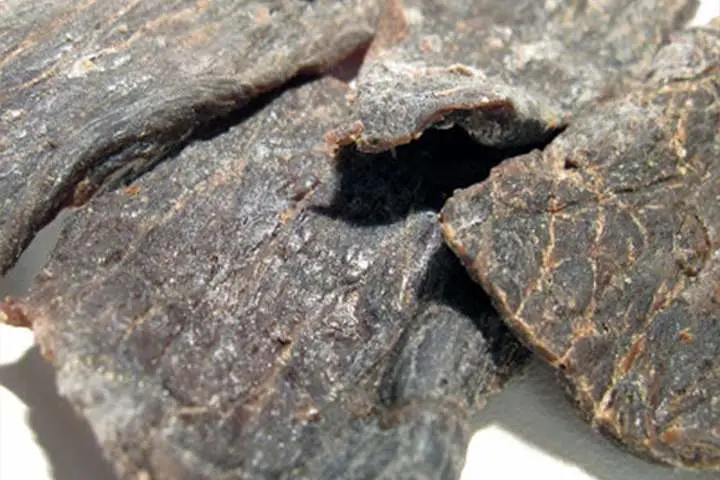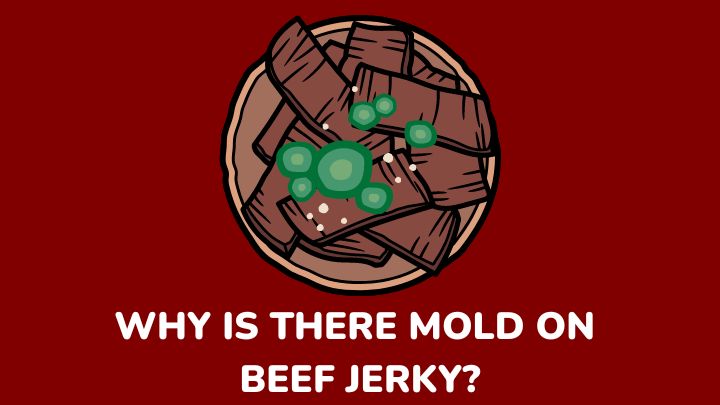Have you recently discovered mold on your beef jerky? If so, then, you need to figure out why and how to ensure your beef jerky never develops mold again.
Moreover, if you are unfamiliar with molds on beef jerky, you will not be able to differentiate what a white or green mold means or whether it indicates that the jerky is bad or not.
Therefore, this article provides more information on beef jerky mold and how to prevent mold from growing on your jerky.
Can beef jerky mold?
Yes, it can.
Molds are tiny fungi that live on dead plant and animal tissue. And since they can live on animal tissue, they can also survive on animal meat.
What causes beef jerky to mold?
Jerky will mold if the liquid in the meat is not sufficiently removed during drying.
Consequently, 90% to 95% of the water content in the meat should be removed during the drying process. When it doesn’t dry properly, the meat’s residual moisture will encourage the growth of mold spores.
What does jerky mold look like?

Mold on jerky frequently has a web-like green-grayish appearance.
What does the salt surface on jerky mean?
Sometimes the white, chalky particle found outside beef jerky is salt, which means it’s okay to eat.
Salt is an essential element of beef jerky. It acts as a natural preservative. Because salt is soluble in liquid, it is soaked up into the meat.
As time passes and humidity continues to evaporate, the salt begins to form visible reserves on the surface of the jerky, which could sometimes cause white particles.
Why does the surface of your beef jerky have fat?
There may occasionally be white solids that look like fat on the surface of beef jerky. This is because beef jerky is made from lean meat, which contains some fat.
Some jerky batches will contain a little more fat and marbling. Short fat solids will stay in the jerky after cooling down, even though the fat is not noticeable while the food is being cooked and dehydrated.
Is it safe to eat jerky with white mold?
No, it is not.
There are many kinds of mold; some are beneficial to products and safe to eat, but others can have negative effects on health.
As a rule, most mold types won’t cause you any harm. However, it is best not to risk it.
What happens if you accidentally eat moldy jerky?
It is best to seek medical advice if you unintentionally ate beef jerky contaminated with mold and experience unpleasant symptoms.
Most healthy people may experience little to no symptoms like nausea, upset tummy, and mild discomfort after eating a small quantity of moldy beef jerky.
Can you get food poisoning from moldy beef jerky?
Spoiled meat is one of the most threatening foods to eat because it can cause foodborne illness.
Food poisoning can cause different symptoms, such as nausea, stomach pain, fever, headaches, and digestive problems.
Furthermore, stale jerky can harbor bacteria that, if digested, can make you sick.
What to do if you find mold on jerky?
If you ever have the feeling there is mold on your jerky, it is always best to discard it.
If mold is found on a piece of jerky, it is recommended you discard the entire package, along with pieces that do not exhibit mold symptoms. It’s best to throw it out if you’re in doubt.
How can you tell if jerky is bad?
Mold and rancidity are two distinct indicators that the jerky has spoiled and is unsafe to consume. Your jerky should be flexible and firm, but not mushy or overly soft.
Furry, chalky, or squishy contaminants that are white, green, or gray are obvious signs of mold.
Another sign of mold is its odor. An “off smell” in the jerky may also indicate the presence of mold.
How can you prevent mold on beef jerky?
There are various ways to keep mold from growing on beef jerky. Here are the most effective ways to start.
1. Dehydrate your beef jerky correctly
Insufficient dehydration is the main factor in the development of mold, so prevention should begin as soon as possible.
Enough drying is required for beef jerky. By doing this, you can ensure the jerky is mold-resistant and shelf-stable.
Mold won’t grow on the jerky if it is dried and packaged properly with little oxygen exposure.
2. Reduce oxygen in your beef jerky packaging
Mold prevention is heavily reliant on proper packaging. With a lack of oxygen, mold cannot grow.
With little oxygen exposure, the likelihood of mold growth is reduced. If you’ve opened a bag of jerky and want to keep it fresh and avoid mold, store it in an airtight container. It doesn’t have to be perfect, but the less air there is, the better.
3. Add an oxygen absorber or desiccant
The tiny packet that can be found in packages of beef jerky is either a desiccant or oxygen absorber. This always helps to absorb moisture from the package. Both solutions reduce the likelihood of mold but in different ways.
4. Don’t keep your beef jerky in the fridge
You do not have to refrigerate the meat if the jerky is packaged and properly dehydrated. While it can slow the mold’s growth, refrigeration also alters the beef jerky’s texture. You can freeze beef jerky if you want to keep it fresh for a very long time.
FAQs
Is beef jerky a healthy snack?
Yes, beef jerky is nutrient-dense and has a few health benefits, including aiding in weight loss.
When consumed in moderation as part of a balanced diet, beef jerky is a great snack that is low in calories and high in protein, and a good source of minerals and vitamins like zinc, iron, choline, and vitamin B12.
Is beef jerky a healthy way to lose weight?
Yes, it is.
Beef jerky is a tasty and efficient part of a wholesome diet for losing weight. It is a versatile and beneficial appetizer that can assist in weight loss and upkeep.
Can you remove mold from beef jerky?
Yes, you can.
You can eat all your jerky unless it is overly “furry.” All types of cured meats are susceptible to developing mold if the surface is not sufficiently dried out either during the curing process or later in a deep freeze as a natural part of aging.
However, if you want to remove mold, you can cut it off, exfoliate it, or wipe it off before eating.
Can you cook mold out of meat?
Yes, you can.
Cooking your meat between 140 and 160°F is sufficient to kill most molds.
Therefore, killing off the mold usually only requires boiling water. But keep in mind that mold does not only grow on the surface. To kill it, heat must permeate the whole jerky.
Conclusion
Most people overlook that beef jerky is a natural food and is susceptible to spoilage if not correctly cured.
As a result, beef jerky is at risk of growing mold if not dried and preserved appropriately. However, sometimes, what appears to be mold may just be salts or fat left over from the meat.
Therefore, before you even consider eating, you must ensure that the jerky doesn’t have mold. If you find out that your beef jerky contains mold, it would be wise to discard it.
You can also remove the molds by redrying the meat once more before eating, preferably through frying. After doing this, ensure to eat all of your beef jerky at once.
Find out if you can make beef jerky with London broil.
Thanks for reading.

